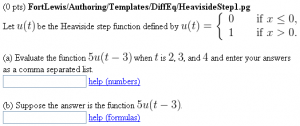Difference between revisions of "HeavisideStep1"
| Line 196: | Line 196: | ||
); |
); |
||
</pre> |
</pre> |
||
| − | If we had defined <code>u(t)</code> this way, we would not have had to add the function <code>step(t)</code> to the context and we could have used the defaults for the answer checker. Notice that the function <code>u(t)</code> is never zero, is not constant, is differentiable, and takes moderately sized values, which makes its answer checking very robust using the defaults for the answer checker. Further, because of the arctangent, it is not periodic and so <code>u(t)-u(t-a)</code> should never be identically zero. Also, the formula for <code>u(t)</code> is not something students are likely to input as an answer out of nowhere. The function <code>u(t)</code> is great as a named function that stands in for the Heaviside function when the answer is a function. However, if the answer is a number obtained by evaluating the Heaviside function, then <code>step(t)</code> should be used |
+ | If we had defined <code>u(t)</code> this way, we would not have had to add the function <code>step(t)</code> to the context and we could have used the defaults for the answer checker. Notice that the function <code>u(t)</code> is never zero, is not constant, is differentiable, and takes moderately sized values, which makes its answer checking very robust using the defaults for the answer checker. Further, because of the arctangent, it is not periodic and so <code>u(t)-u(t-a)</code> should never be identically zero. Also, the formula for <code>u(t)</code> is not something students are likely to input as an answer out of nowhere. The function <code>u(t)</code> is great as a named function that stands in for the Heaviside function when the answer is a function. However, if the answer is a number obtained by evaluating the Heaviside function, then <code>step(t)</code> should be used or the function <code>u(t)</code> should be properly defined as the Heaviside function for obvious reasons. |
</p> |
</p> |
||
</td> |
</td> |
||
Revision as of 22:43, 6 December 2010
Using the Heaviside Step Function
This PG code shows how to add a the Heaviside step function step(x), which takes the value 1 if x > 0, and the value 0 if x ≤ 0, to the context. It also shows how to add a named function u(x) to the context that has a reliable answer checker and can stand in for the Heaviside step function when the student answer is a function.
- Download file: File:HeavisideStep1.txt (change the file extension from txt to pg when you save it)
- File location in NPL:
FortLewis/Authoring/Templates/DiffEq/HeavisideStep1.pg
| PG problem file | Explanation |
|---|---|
|
Problem tagging: |
|
DOCUMENT(); loadMacros( "PGstandard.pl", "MathObjects.pl", "AnswerFormatHelp.pl", "parserFunction.pl", ); TEXT(beginproblem()); |
Initialization:
We load |
Context("Numeric");
Context()->variables->are(t=>"Real");
Context()->functions->add(
step => {
class => 'Parser::Legacy::Numeric',
perl => 'Parser::Legacy::Numeric::do_step'
},
);
$a = 3;
$ftex = "5 u(t-$a)";
$fstep = Formula("5*step(t-$a)");
$answer1 = List($fstep->eval(t=>2),$fstep->eval(t=>3),$fstep->eval(t=>4));
|
Setup 1:
We add the step function to the context with the name For more details on adding the Heaviside function to the context, see the forum discussion on the Heaviside step function |
Context()->texStrings;
BEGIN_TEXT
Let \( u(t) \) be the Heaviside step function
defined by
\( \displaystyle
u(t) =
\left\lbrace
\begin{array}{lcl}
0 && \mbox{ if } x \leq 0, \\
1 && \mbox{ if } x > 0.
\end{array}
\right.
\)
$BR
$BR
(a) Evaluate the function \( $ftex \) when
\( t \) is \(2\), \(3\), and \(4\) and enter
your answers as a comma separated list.
$BR
\{ ans_rule(20) \}
\{ AnswerFormatHelp("numbers") \}
END_TEXT
Context()->normalStrings;
|
Main Text 1: |
$showPartialCorrectAnswers=1; ANS( $answer1->cmp(ordered=>1) ); |
Answer Evaluation 1: |
Context("Numeric");
Context()->variables->are(t=>"Real");
Context()->functions->add(
step => {
class => 'Parser::Legacy::Numeric',
perl => 'Parser::Legacy::Numeric::do_step'
},
);
parserFunction("u(t)" => "step(t)");
$f = Formula("5 u(t-$a)");
$answer2 = $f->with(
limits=>[$a-5,$a+5],
test_at => [[$a-1],[$a-0.0000001],[$a+0.0000001],[$a+1]],
num_points=>10,
);
|
Setup 2:
We reset the context using
Using a different method for adding functions to the context, we add the named function
Since answers are checked numerically by comparing the student answer to the correct answer at several randomly points in the domain (the default is 5 points) in an interval (the default is [-1,1]), the function
To make the answer checking robust, in
In part (b), since the students never actually see the values of the function parserFunction("u(t)" =
"1.5 * sin(e*t) + 5*pi/3 + arctan(t)"
);
If we had defined |
Context()->texStrings;
BEGIN_TEXT
$BR
$BR
(b) Suppose the answer is the function \( $ftex \).
$BR
\{ ans_rule(20) \}
\{ AnswerFormatHelp("formulas") \}
END_TEXT
Context()->normalStrings;
|
Main Text 2: |
ANS( $answer2->cmp() ); |
Answer Evaluation 2: |
Context()->texStrings;
BEGIN_SOLUTION
${PAR}SOLUTION:${PAR}
Solution explanation goes here.
END_SOLUTION
Context()->normalStrings;
COMMENT('MathObject version.');
ENDDOCUMENT();
|
Solution: |
